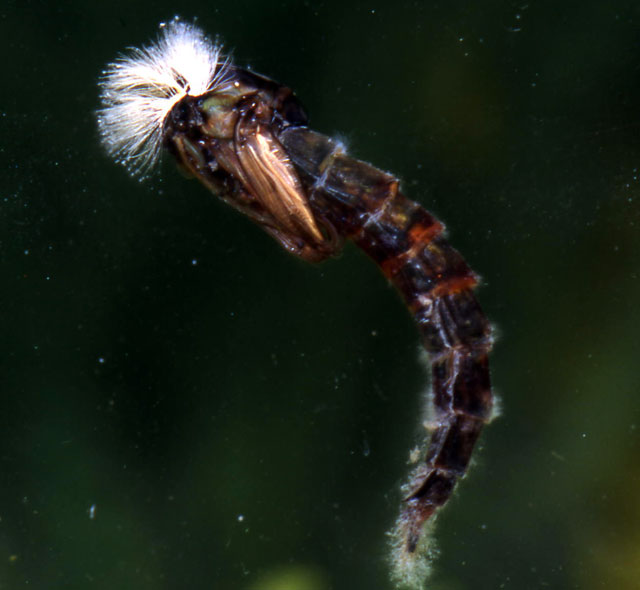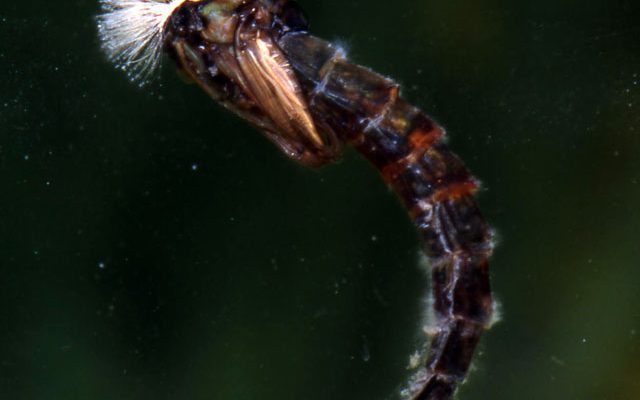From behind the cover of a boulder, the largemouth slipped into the edge of the current, inspected my midgefly and then drifted back to the shelter of the rock. The rise left a dimple on the surface that soon dissipated, but it lasted long enough for me to spot the quarry.
I stripped out 30 feet of fly line from my reel and began casting. The line moved backward in a sideways “U,” then forward in another tight loop, and the small imitation of a midge floated gently to the surface.
The bass moved slightly, rose and took the fly. I set the hook, and the fight was on.
On a nearby bank, a young couple watched. The woman turned to her companion and said, “I wish I could do that. It looks so relaxing and peaceful, but I could never learn anything that complicated.”
The truth is, she can learn to fly fish. Anyone can.
Henry Doyle, owner of Doyle’s Fly Shop in Branson, Mo., perhaps said it best. “The beauty of fly fishing is that it allows you to find your own level of enjoyment. You can be an occasional angler or you can go deep — learning Latin words for bugs, making your own rods, tying your own flies,” he said. “So long as it’s fun for you, that’s all that matters.”
Few places in mid-America are better suited for fly fishing than Lake Taneycomo. Short for Taney County Missouri, Lake Taneycomo was created in 1913 when the White River was captured by the newly constructed “Power Site” Dam near Forsyth, Mo. Construction of Table Rock Dam in 1958, 22 miles upstream, created a southern boundary for Lake Taneycomo, which today contains 2,000 surface acres.
From 1913 until 1958, Taneycomo was a “warm water” lake; however, when Table Rock Dam started feeding it, the water coming through the power generators was significantly lower in temperature. Virtually overnight, a “cold water” fishery was created. To take advantage of this change, the Missouri Department of Conservation (MDC) constructed the Shepherd of the Hills Trout Hatchery, located directly below Table Rock Dam. Since trout don’t naturally reproduce in Lake Taneycomo, the hatchery — Missouri’s largest — provides 750,000 trout annually for stocking in the lake.
Two species of trout flourish here: rainbows and browns. Rainbow trout are more common. Brown trout are fighters but less inclined to clear the water in the reckless leaps of a rainbow. Browns are nonetheless worthy of attention in their own right. They achieve noteworthy size and are generally more difficult to catch than either brook or rainbow trout, thus providing a challenge to seasoned fly anglers.
Browns are particularly well suited for angling activity when most of the world is resting. During the inky period between dusk and dawn, brown trout become most active. To catch more of them, stay on the water until the tip of your fly rod disappears in the darkness. Browns will oftentimes bite long after other trout have stopped feeding.
Brown trout eagerly devour minnows. Thus, flies that imitate fingerlings are particularly effective. I’ve caught browns on nymphs and dry flies, but some of the biggest I’ve netted have fallen for a Muddler Minnow. Muddlers and other minnow-type flies are easy to fish. The key is to keep them down near the bottom, within sight of a lurking brown. To accomplish this feat with floating line, attach small splitshot or other weight six to eight inches above the fly. Cast upstream, then strip in your fly line to match the speed of the current.
Midge Fishing
Particularly on Lake Taneycomo’s upper portion, the midge, of the insect order Diptera and the family Chironomidae, is a major part of the rainbow and brown trout’s diet. If you’re not fishing midges as part of your fly-fishing repertoire, you’re ignoring Taneycomo’s primary “hatch,” as midges are constantly hatching here just about every day of the year.
Of the four major stages of a midge’s life cycle — egg, larvae, pupae and adult — it’s when the midge emerges from its pupae stage and is transitioning into an adult that an angler has the best opportunity to use midge imitations to catch trout on Lake Taneycomo. While there are some skilled fly fishermen who fish size 26 and smaller larval imitations successfully, and some who fish adult imitations, most anglers will likely have the best results as the midge emerges from its pupae state.

As a midge transitions, it rises through a water column, from the bottom to the surface, where it completes its transition into an adult. As a midge travels up the water column, it’s at its largest sub-surface size and thus presents an ideal target to hungry trout.
On a day-to-day basis, I rely on Zebra Midge patterns — Copper Dun, Primrose and Pearl, Rusty and Ugly in size 18 — as well as the Red Tungsten Bead Head in size 16. These, I’ve found, provide the best midge trout fishing excitement. These patterns are available at River Run Outfitters, which is located on Highway 165 near Table Rock Dam.
Except for the very early morning, my two most used midges are the Ugly and the Rusty. Only if they don’t work will I try another pattern. In the very early morning hours, just after sunrise to about an hour after, I start with a size 16 Red Tungsten Bead head and transition over to the Ugly and Rusty, if I’ve had no success with the Red.
Presentation is important. Most of my boat fishing on Lake Taneycomo is done with an indicator. I use a 5/16th Lightning Strike Ball Indicator for size 18 flies and a 3/8th size for 16s. When midge fishing, I have the best results using the smallest indicator possible.

Where to Fly Fish
Many fly fishermen head towards the tailwater section of Lake Taneycomo, from just below Table Rock Dam to the mouth of Fall Creek. The MDC maintains a Trophy Trout Management Zone in this stretch of the fishery. Below Fall Creek, anglers fish from the banks and boats and often catch large numbers of trout.
In the Trophy Management Zone, the MDC maintains a slot limit on trout. Rainbows from 12 to 20 inches must be immediately returned to the water; Browns less than 20 inches must also be released. It’s not uncommon to see anglers wading out of these waters with a stringer full of keeper trout, but a fly angler usually has to catch and release several fish for each one that can be legally possessed.
Deep Water Problems
Running near and through Branson, Lake Taneycomo is one of the most prolific trout fisheries in America. Yet, because of its “tail water” status at the foot of Table Rock Dam, it poses unique challenges for the fly angler. When the dam isn’t generating power, it provides easily accessible wade fishing from the dam to about two miles downstream; however, the situation changes dramatically when power generating starts.
Water rises rapidly from the no-generation level of about 702 feet above sea level to elevations exceeding 710 feet, with a current velocity to match. Don’t scorn the warning horn when it sounds; exit the water immediately. Let the water stabilize, then decide whether to continue fishing.
When more than one generator is being used at Table Rock Dam, wade fishing is difficult and becomes increasingly more so as the number of generators that are being used increases. Although anglers can call 417-336-5083 to get the latest information on power generation times, the situation can change soon after you make the call. There is, in fact, no way to know with certainty what the generator status is at the dam five minutes removed from any given point in time.
The only way a fly angler can be guaranteed that he or she will be able to fly fish on a certain day at a specific time is to fish from a boat. Although a boat does make fly fishing possible, doing so effectively under high water conditions is another matter. What flies to use, at what depths and many other variables that come into play under high water conditions present challenges that are further complicated by trying to control a boat in fast-moving water.
The best advice to give to persons who’ve not pursued trout on Lake Taneycomo with a fly when water is running heavy is to fly fish from a boat with a knowledgeable guide. Guides are available at Lilleys’ Landing, Chartered Waters Guide Service and River Run Outfitters.
If You Go
Over the past half-century, many stories have appeared in magazines concerning Lake Taneycomo’s premiere trout fishery. Its transition from a warm-water lake containing bass and catfish to a cold-water lake full of rainbow and brown trout made big news. Later, as growth of the Branson area surrounding the lake attracted more and more anglers, many in the press predicted Taneycomo’s decline as an important fishery.
What a pleasant surprise, then, to find that Lake Taneycomo has met all the challenges and is still considered one of America’s best fly-fishing destinations. The trout are getting larger, not smaller, and a successful management program has improved fishing for everyone. The rainbow and brown trout that ply the waters of Lake Taneycomo provide exciting, year-round fishing. Come here expecting to get all the fishing action you desire and plan on returning to America’s Heartland soon for a one-of-a-kind fly fishing experience.
Should you plan a trip to Lake Taneycomo, there are a couple of things you should do: First, make sure to get a Missouri fishing license and trout stamp. Second, familiarize yourself with the limit, size and bait rules that apply to different sections of the fishery.
Lake Taneycomo has 22 miles of shoreline, and the average water temperature is 48 degrees Fahrenheit. Boaters should dress appropriately for cold-water temperatures.
Lake Taneycomo Guides
Chartered Waters Guide Service – 866-362-1928; www.charteredwaters.com
Lilleys’ Landing – 417-334-6380, www.lilleyslanding.com
River Run Outfitters – 877-699-3474; www.riverrunoutfitters.com




